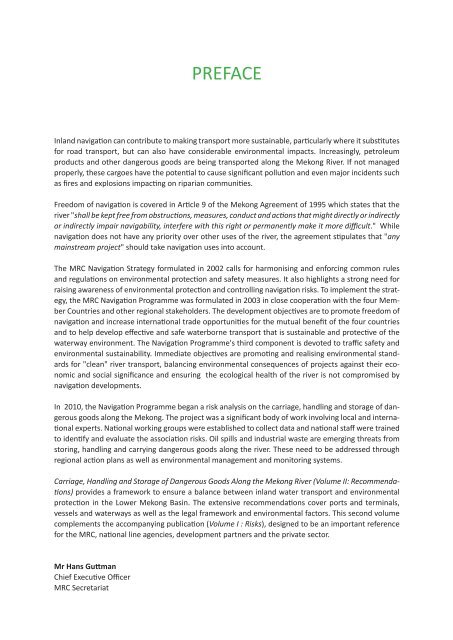Carriage, Handling and Storage of Dangerous Goods along
Carriage, Handling and Storage of Dangerous Goods along
Carriage, Handling and Storage of Dangerous Goods along
Create successful ePaper yourself
Turn your PDF publications into a flip-book with our unique Google optimized e-Paper software.
PREFACE<br />
Inl<strong>and</strong> navigation can contribute to making transport more sustainable, particularly where it substitutes<br />
for road transport, but can also have considerable environmental impacts. Increasingly, petroleum<br />
products <strong>and</strong> other dangerous goods are being transported <strong>along</strong> the Mekong River. If not managed<br />
properly, these cargoes have the potential to cause significant pollution <strong>and</strong> even major incidents such<br />
as fires <strong>and</strong> explosions impacting on riparian communities.<br />
Freedom <strong>of</strong> navigation is covered in Article 9 <strong>of</strong> the Mekong Agreement <strong>of</strong> 1995 which states that the<br />
river "shall be kept free from obstructions, measures, conduct <strong>and</strong> actions that might directly or indirectly<br />
or indirectly impair navigability, interfere with this right or permanently make it more difficult." While<br />
navigation does not have any priority over other uses <strong>of</strong> the river, the agreement stipulates that "any<br />
mainstream project" should take navigation uses into account.<br />
The MRC Navigation Strategy formulated in 2002 calls for harmonising <strong>and</strong> enforcing common rules<br />
<strong>and</strong> regulations on environmental protection <strong>and</strong> safety measures. It also highlights a strong need for<br />
raising awareness <strong>of</strong> environmental protection <strong>and</strong> controlling navigation risks. To implement the strategy,<br />
the MRC Navigation Programme was formulated in 2003 in close cooperation with the four Member<br />
Countries <strong>and</strong> other regional stakeholders. The development objectives are to promote freedom <strong>of</strong><br />
navigation <strong>and</strong> increase international trade opportunities for the mutual benefit <strong>of</strong> the four countries<br />
<strong>and</strong> to help develop effective <strong>and</strong> safe waterborne transport that is sustainable <strong>and</strong> protective <strong>of</strong> the<br />
waterway environment. The Navigation Programme's third component is devoted to traffic safety <strong>and</strong><br />
environmental sustainability. Immediate objectives are promoting <strong>and</strong> realising environmental st<strong>and</strong>ards<br />
for "clean" river transport, balancing environmental consequences <strong>of</strong> projects against their economic<br />
<strong>and</strong> social significance <strong>and</strong> ensuring the ecological health <strong>of</strong> the river is not compromised by<br />
navigation developments.<br />
In 2010, the Navigation Programme began a risk analysis on the carriage, h<strong>and</strong>ling <strong>and</strong> storage <strong>of</strong> dangerous<br />
goods <strong>along</strong> the Mekong. The project was a significant body <strong>of</strong> work involving local <strong>and</strong> international<br />
experts. National working groups were established to collect data <strong>and</strong> national staff were trained<br />
to identify <strong>and</strong> evaluate the association risks. Oil spills <strong>and</strong> industrial waste are emerging threats from<br />
storing, h<strong>and</strong>ling <strong>and</strong> carrying dangerous goods <strong>along</strong> the river. These need to be addressed through<br />
regional action plans as well as environmental management <strong>and</strong> monitoring systems.<br />
<strong>Carriage</strong>, <strong>H<strong>and</strong>ling</strong> <strong>and</strong> <strong>Storage</strong> <strong>of</strong> <strong>Dangerous</strong> <strong>Goods</strong> Along the Mekong River (Volume II: Recommendations)<br />
provides a framework to ensure a balance between inl<strong>and</strong> water transport <strong>and</strong> environmental<br />
protection in the Lower Mekong Basin. The extensive recommendations cover ports <strong>and</strong> terminals,<br />
vessels <strong>and</strong> waterways as well as the legal framework <strong>and</strong> environmental factors. This second volume<br />
complements the accompanying publication (Volume I : Risks), designed to be an important reference<br />
for the MRC, national line agencies, development partners <strong>and</strong> the private sector.<br />
Mr Hans Guttman<br />
Chief Executive Officer<br />
MRC Secretariat













